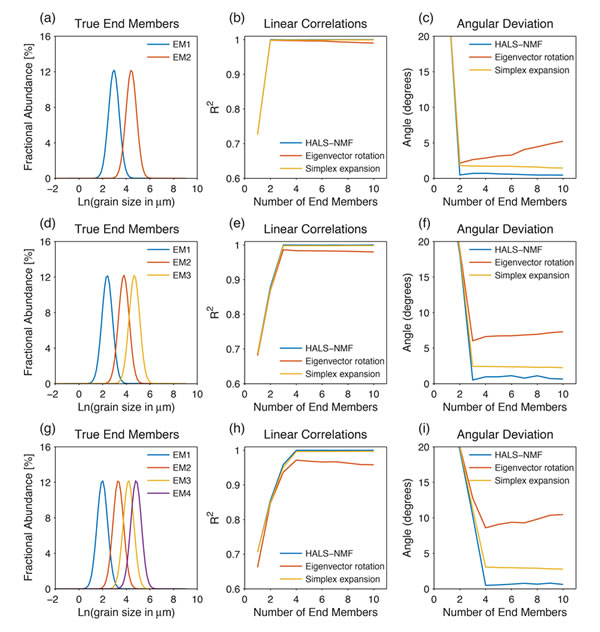Grain size distribution (GSD) data are widely used in Earth sciences and although large data sets are regularly generated, detailed numerical analyses are not routine. Unmixing GSDs into components (called end members) can help understand sediment provenance and depositional regimes/processes. Attempts at unmixing GSD data have a long history in sedimentology, but despite the potential of unmixing, numerous studies do not take advantage of this useful mathematical representation. This may, in part, be due to a lack of widely available, user-friendly software that allows the rapid processing of large data sets.
Taking inspiration from the hyperspectral image analysis community, Associate Prof. Greig A. Paterson from IGGCAS, along with collaborator Dr David Heslop from the Australian National University, developed a new non-parametric algorithm for unmixing sediment grain size data. When compared to the algorithms currently used for unmixing sediment data, this new method consistently outperforms existing methods in terms of fitting the data and accurately identifying the true end members and their abundances (Figures 1 and 2).
Another widely used approach to unmix GSD data is single specimen unmixing (SSU), which unmixes individual GSDs into unimodal parametric distributions (e.g., lognormal). This work, however, demonstrates that the inherent non-uniqueness of SSU solutions renders this approach unviable for estimating underlying mixing processes. To overcome this, Paterson & Heslop develop a new algorithm to perform parametric unmixing, whereby an entire data set can be unmixed into unimodal parametric end members (e.g., Weibull distributions). This makes it easier to identify individual grain size sub-populations in highly mixed data sets.
To help researchers process their grain size data, the authors created a new software package called AnalySize, which contains all of the newly developed algorithms. AnalySize is MATLAB based GUI software that has an easy to use interface and supports a wide range of data formats. The software incorporates a number of standard grain size analyses including ternary diagrams, Passega’s CM plot, and a range of descriptive statistics. AnalySize can also produce figures that are publication ready with no or minimal adjustment. The software is available for download at https://github.com/greigpaterson/AnalySize.
This work has now been published in Geochem. Geophys. Geosyst.

Figure 1. Synthetic lognormal end member GSDs and goodness-of-fit statistics for unmixing of data sets of 200 specimens that are comprised of (a–c) 2, (d–f) 3, and (g–i) 4 end members. Linear correlations are between the estimated (unmixed) and true data sets. Angular deviation is the angular difference between the estimated (unmixed) and true data sets. In the goodness-of-fit plots, HALS-NMF refers to our new algorithm, eigenvector rotation and simplex expansion are two currently employed algorithms.

Figure 2. Fitting results from different non-parametric methods when applied to the 4 end member data set in Figure 1g–i. (a–d) Comparison between the fitted and true end members. (e–h) Comparison between the estimated and true abundances.
Contact:
Greig A. Paterson
E-mail: greig.paterson@mail.iggcas.ac.cn
Division of the Earth's Deep Structure and Process,IGGCAS(http://english.igg.cas.cn/)